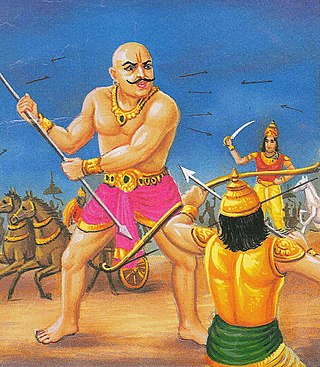
Ghatotkacha is a prominent character in the story of Mahabharata. His name comes from the fact that his head was hairless (utkacha) and shaped like a ghatam, or a pot. Ghatotkacha was the son of the Pandava Bhima and the demoness Hidimbi, and thus a half-human, half-demon hybrid.

Tanhaji Malusare was a warrior and commander of Shivaji. A local poet Tulsidas, wrote a powada describing Subhedar Tanhaji's heroics and sacrifice of life in the Battle of Sinhagad, which has since made him a popular figure in Indian folklore.
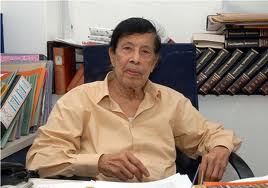
Anant Pai, popularly known as Uncle Pai, was an Indian educationalist and a pioneer in Indian comics. He is most famous as the creator of two comic book series viz. Amar Chitra Katha, which retold traditional Indian folk tales, mythological stories, and biographies of historical characters; and Tinkle, a children's anthology.
Chitrakatha are comics or graphic novels originating from India published in a number of Indian languages.
Gotham Entertainment Group LLC was an American company established in 1997 to establish a leadership position in the Indian comic magazine and children's book market. The company was established by executives in the industry including the former CEO of Time-Life, the former Presidents of Warner Music Media and Bertelsmann Music Group (BMG) Direct, and the former Regional Creative Director of J. Walter Thompson-Asia Pacific. Gotham's CEO, Sharad Devarajan, is an entrepreneur with prior media experience at MTV Networks, Ford Modeling Agency, Elektra Entertainment, and DC Comics.

Tinkle is an Indian weekly magazine for children in English, published from Mumbai. Originally owned by the India Book House, the Tinkle brand was acquired by ACK Media in 2007. The magazine contains comics, stories, puzzles, quizzes, contests and other features targeted at school children, although its readership includes many adults as well. It is published in English and syndicated in many Indian languages like Hindi, Bengali, and Malayalam.

India Book House Pvt. Limited (IBH) is an importer, distributor and publisher of books and magazines in India.

Chitra Ganesh is a visual artist based in Brooklyn, New York. Ganesh's work across media includes: charcoal drawings, digital collages, films, web projects, photographs, and wall murals. Ganesh draws from mythology, literature, and popular culture to reveal feminist and queer narratives from the past and to imagine new visions of the future.
The Mahabharata is one of the two major Sanskrit epics of ancient India, the other being the Ramayana.
Balarama is an Indian weekly comic magazine published by M. M. Publications, of Malayala Manorama Group from Kottayam, Kerala in Malayalam language. It is one of the most widely read children's magazines in India. Balarama celebrated its 50th year of publication in the year 2022.

Shikari Shambu is an Indian comics character created by Vasant Halbe and Luis Fernandes for the Tinkle magazine in 1983. Shikari Shambu is one of the characters of Tinkle.
Ram Waeerkar was an Indian comics artist for the series Amar Chitra Katha, based on Indian mythology, history, and folklore. He illustrated the very first issue, 'Krishna' in 1969, and many others later. In the 1980s he was an illustrator for Tinkle, a magazine edited by Anant Pai. Here, he was the man behind the art of such iconic characters as Suppandi, Pyarelal, Nasruddin Hodja, Choru and Joru and many more. Ram Waeerkar died in 2003, with comics on Chanakya and Vishwamitra as his last projects. His daughter Archana Amberkar has been an artist for Tinkle magazine ever since and his son Sanjiv Waeerkar too illustrated for Tinkle in the early 1990s.
C M. Vitankar was an illustrator who created several covers for the popular Indian comic book series Amar Chitra Katha, as well another lesser-known series Manoj Chitra Katha. He also worked in the Hindi film industry in Mumbai as a poster artist, according to Nandini Chandra, author of The Classic Popular: Amar Chitra Katha, 1967-2007. He did the artworks for different Amar Chitra Katha comics like 'Ganesha', 'Tales of Shiva', 'Arjuna', 'the Monkey and the Boy' and 'Karttikeya' edited and published by Anant Pai
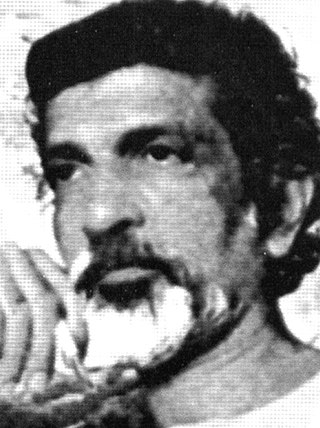
Pratap Mullick was an Indian illustrator and comics artist. He was best known for illustrating Nagraj of Raj Comics which gained lot of popularity under him and was later handed to Anupam Sinha who made Nagraj an actual superhero. He worked for the Indian comic book series Amar Chitra Katha created by writer and editor Anant Pai. Mullick drew the first 50 issues of Nagraj from 1986 until 1995. He designed the comic-book character Supremo, who featured in a series published for two years in the 1980s.
Yusuf Lien also known as Yusuf Bangalorewala is an Indian book illustrator best known for his work on the Amar Chitra Katha comic book series, which deals with subjects from Indian myth, legend and history. His dream-like sensual work on the titles Tansen and Mirabai is admired by many who believe he had one of the most distinctive styles among the Amar Chitra Katha artists. According to researcher John Stratton Hawley, the Amar Chitra Katha staff took a 'nonsectarian pride' that the exquisite depictions of Krishna in Mirabai were the work of a Muslim artist, who as his editor Anant Pai described it, would be in tears as he drew his frames for the comic book. Yusuf also painted the image of the child Krishna seen on the cover of the comic book of the same name.
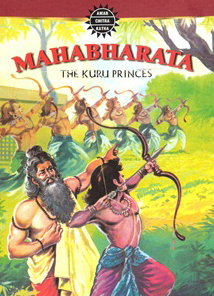
Mahabharata is a comic adaptation of the Indian epic poem Mahabharata. The 42-issue best-selling series by Amar Chitra Katha, Mumbai was illustrated by Dilip Kadam. The team of script writers included Kamala Chandrakant, TMP Nedungadi, Subba Rao, Yagya Sharma, Lopamudra, Mihir Lal Mitra, Sumona Roy, Mohan Swaminathan, Shubha Kandhekar and Margie Sastry.
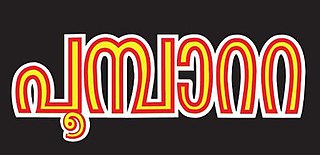
Poompatta was a Malayalam comic magazine started publishing in 1964. It was initially owned by P. A. Warrier and later by Sithara Publications and from 1978 by Pai and Pai Company (PAICO). Poompatta under PAICO was the first Malayalam children's publisher to syndicate comics produced by India Book House and publish Amar Chitra Katha in Malayalam.

Epic TV is an Indian television channel that airs action, drama, comedy and narrative non-fiction and fictional programming with a focus on Indian history, folklore and epic genre. Launched by IN10 Media on 19 November 2014, a company owned by Anand Mahindra, it airs programmes in Hindi and English. Aditya Pittie, CEO of Pittie Group is the Managing Director of Epic TV.










